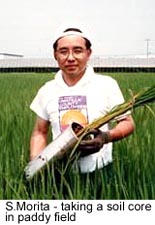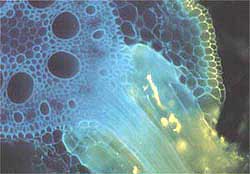 Scope
of the 6th ISRR Symposium
Scope
of the 6th ISRR Symposium Roots: the Dynamic Interface Between Plant and the Earth
Nagoya, Japan ; November 11-15, 2001
 Scope
of the 6th ISRR Symposium
Scope
of the 6th ISRR Symposium
Roots: the Dynamic Interface Between
Plant and the Earth
Nagoya, Japan ; November 11-15, 2001
Establishment of "Rhizology"
 The objective
of the 6th ISRR Symposium is to characterize morphology and function of
whole root systems as the most dynamic interface between plants and soil
within the Earth's geosphere. Plant roots anchor the whole plant, absorb
water and nutrients. Additionally, roots are biological sensors which receive
and process environmental stimuli into chemical signals which control the
growth and development of both shoots and roots. Moreover, root exudates
greatly contribute carbon and nitrogen to microorganisms and other components
of the food web with the soil ecosystem. Root channels, rhizospheres, uptake
of water and nutrients modify many abiotic soil conditions. Root development,
demographics within the soil profile, and seasonal functions must all be
considered when formulating a sustainable agriculture agro-ecosystem and
global carbon cycle. Rapid increases in the global population continues
to result in famine during the early part of the 21st Century. Therefore,
whole-plant research efforts are essential before we can achieve high and
stable crop production. Combining whole plant genomics with soil management
practices, e.g., tillage, nutrient fertilization and water management,
are essential contributions to maintaining maximum sustainable yields.
Therefore information on root system development is essential to make decision
for effective management practices. On the other hand, environmental issues,
e.g., flooding, drought, acid rain, desertification, salt accumulation,
increases in global carbon gases, and heavy metal pollution, can be addressed
by research on plant root systems. That is another reason why root research
must be proceeded urgently.
The objective
of the 6th ISRR Symposium is to characterize morphology and function of
whole root systems as the most dynamic interface between plants and soil
within the Earth's geosphere. Plant roots anchor the whole plant, absorb
water and nutrients. Additionally, roots are biological sensors which receive
and process environmental stimuli into chemical signals which control the
growth and development of both shoots and roots. Moreover, root exudates
greatly contribute carbon and nitrogen to microorganisms and other components
of the food web with the soil ecosystem. Root channels, rhizospheres, uptake
of water and nutrients modify many abiotic soil conditions. Root development,
demographics within the soil profile, and seasonal functions must all be
considered when formulating a sustainable agriculture agro-ecosystem and
global carbon cycle. Rapid increases in the global population continues
to result in famine during the early part of the 21st Century. Therefore,
whole-plant research efforts are essential before we can achieve high and
stable crop production. Combining whole plant genomics with soil management
practices, e.g., tillage, nutrient fertilization and water management,
are essential contributions to maintaining maximum sustainable yields.
Therefore information on root system development is essential to make decision
for effective management practices. On the other hand, environmental issues,
e.g., flooding, drought, acid rain, desertification, salt accumulation,
increases in global carbon gases, and heavy metal pollution, can be addressed
by research on plant root systems. That is another reason why root research
must be proceeded urgently.
 Root research
has been behind shoot studies, because it is tedious and time-consuming.
However, methodology for root research has been standardized after trials
of many root researchers. Recently, new methodologies in the disciplines
of molecular and cell biology, synchrotron and microtomographic electron
microscopy have proven to be quite effective for investigating root processes.
Roots are highly suitable organs for studying their molecular and cell
biology because their anatomical morphologies are quite simple. Such studies
using root as a research material are also quite useful to understand morphology
and function of an individual root as well as the whole root system. The
goal of the 6th ISRR Symposium is to meet researchers studying many different
root subjects, to discuss morphological forms of roots which impact their
functions at the dynamic interface between plants and the earth and to
establish NEGAKU as a newly integrated research area of rhizology.
Root research
has been behind shoot studies, because it is tedious and time-consuming.
However, methodology for root research has been standardized after trials
of many root researchers. Recently, new methodologies in the disciplines
of molecular and cell biology, synchrotron and microtomographic electron
microscopy have proven to be quite effective for investigating root processes.
Roots are highly suitable organs for studying their molecular and cell
biology because their anatomical morphologies are quite simple. Such studies
using root as a research material are also quite useful to understand morphology
and function of an individual root as well as the whole root system. The
goal of the 6th ISRR Symposium is to meet researchers studying many different
root subjects, to discuss morphological forms of roots which impact their
functions at the dynamic interface between plants and the earth and to
establish NEGAKU as a newly integrated research area of rhizology.
July 1, 1999
Shigenori Morita,
Chairperson of the Organizing Committee